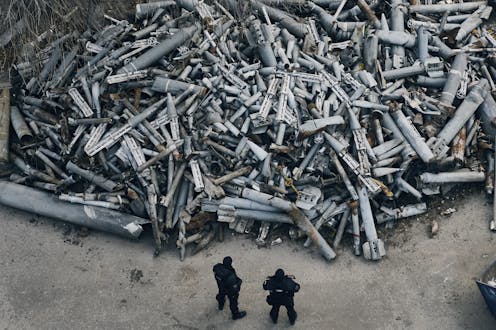
The decision by the United States to donate DPICMs (dual-purpose improved conventional munitions) — known as cluster bombs — to Ukraine has been met with withering criticism, with a BBC report suggesting that it would “knock away much of the moral ground” the U.S. has had in its support of Ukraine.
There are legitimate concerns about cluster munitions — the Convention on Cluster Munitions that commits signatories to never using, developing, or assisting others to use cluster munitions is indicative of this. But it’s important to place these weapons in the context of international humanitarian law — the “laws of war” — and examine the way Ukraine intends to deploy them.
In doing so, it becomes apparent that nuance is missing in accusations of harm and hypocrisy.
How cluster bombs work
Cluster munitions are a method of deploying small explosive charges (“sub-munitions”) over a large area. The name covers a variety of weapons, dispersing from tens to hundreds of sub-munitions, designed to be fired or dropped in different ways.
The cluster munitions donated to Ukraine by the U.S. are fired from artillery, and each cannister contains either 88 or 76 sub-munitions. Depending on the height from which the sub-munitions are released, a single round can cover up to 30,000 square metres.
The “laws of war” are founded on six principles, three of which are particularly relevant in the Ukraine situation:
- A distinction must be drawn between combatants and civilians (principle of discrimination);
- Collateral damage must not be excessive in relation to the direct military advantage (principle of proportionality);
- Weapons that cause unnecessary suffering are prohibited.
The criticism of the U.S. decision to donate cluster munitions to Ukraine is based on potential civilian harm, as well as the perceived hypocrisy of facilitating the use of a weapon Russia was condemned for using in Ukraine.
The dangers of cluster bombs
Cluster munitions have two concerning features. First is the impossibility of pinpointing exactly where each sub-munition will detonate. Consequently, using cluster munitions in the midst of a civilian population (as Russia did in Kharkiv in 2022) risks violating the principle of discrimination: there is no certainty that casualties will be military.
It is similarly difficult to calculate likely collateral damage. This makes it devastatingly challenging to meet the criteria of proportionality when used in areas of high civilian population.
Second, it’s possible that not all of the sub-munitions detonate, and unexploded bombs can kill or injure civilians after the conflict. Vietnamese and Laotian civilians continue to be injured by sub-munitions deployed by U.S. forces more than 40 years ago.

Similarly, the Soviet Union in Afghanistan and the U.S. in Vietnam used “butterfly” cluster munitions, designed to be triggered by someone attempting to handle the innocuous-looking object, rather than detonating in the air.
Again, this raises the potential for civilian casualties that outweighs military advantage.
Ukraine’s use of cluster bombs
Both of these threats represent strong reason to limit cluster munitions. However, they don’t really apply to Ukraine’s anticipated use of them.
Unlike, for example, blinding lasers (banned under the Protocol on Blinding Laser Weapons) — which are deemed to violate the third principle of the laws of war noted above (causing unnecessary suffering to the individual who is affected by the weapon) — there is little meaningful difference between cluster munitions and any other explosive munition.
If used improperly, they may violate the first and second principles. However, when used against military targets, they aren’t understood to cause “unnecessary suffering” to the combatants who are targeted, with the cluster munitions simply replicating the effects of firing a large number of small bombs.
These weapons are intended to enable the Ukrainian military to defeat the invading Russian forces and, as has been demonstrated by their use in the past weeks, are well-suited to current battlefield conditions.

Ukraine has committed to only using them on Ukrainian territory, and it would therefore be counter-productive to deploy them in civilian centres and harm its own citizens. The potential for direct harm to civilians is therefore low.
Second, the “dud rate” (the likelihood of unexploded sub-munitions) of the DPICMs being provided by the U.S. is significantly lower than that of similar munitions.
Cluster munitions used by Russia in 2022, for example, are estimated to have had a “dud rate” of between 30 and 40 per cent. The U.S. military has indicated that the “dud rate” of the DPICM is around 2.5 per cent.
That means of the 88 sub-munitions, two may not detonate. A single “dud” is dangerous, but the use of DPICMs against military targets is less likely to cause long-term harm to the Ukrainian civilian population than in countries where cluster munitions have been used previously.
Misunderstanding effects
Unlike “butterfly” bombs, DPICMs are not designed to linger on the ground. In addition, Ukraine is likely to use DPICMs in areas where Russia has deployed large numbers of landmines, which will require clearance before civilians return.
The potential addition of unexploded sub-munitions isn’t trivial, but the current presence of landmines reduces its relative importance.
Framing the decision to donate cluster munitions to Ukraine as hypocritical indicates a misunderstanding of the context of how they are used.
Ideally, Russia would withdraw from Ukraine peacefully. Absent this, cluster munitions represent an effective way for Ukraine to defeat Russia’s invasion, and the Ukrainian use of these weapons is unlikely to violate the principles of the laws of war.
Thomas Hughes is affiliated with the Centre for Defence and Security Studies, and the North American and Arctic Defence and Security Network.
This article was originally published on The Conversation. Read the original article.







